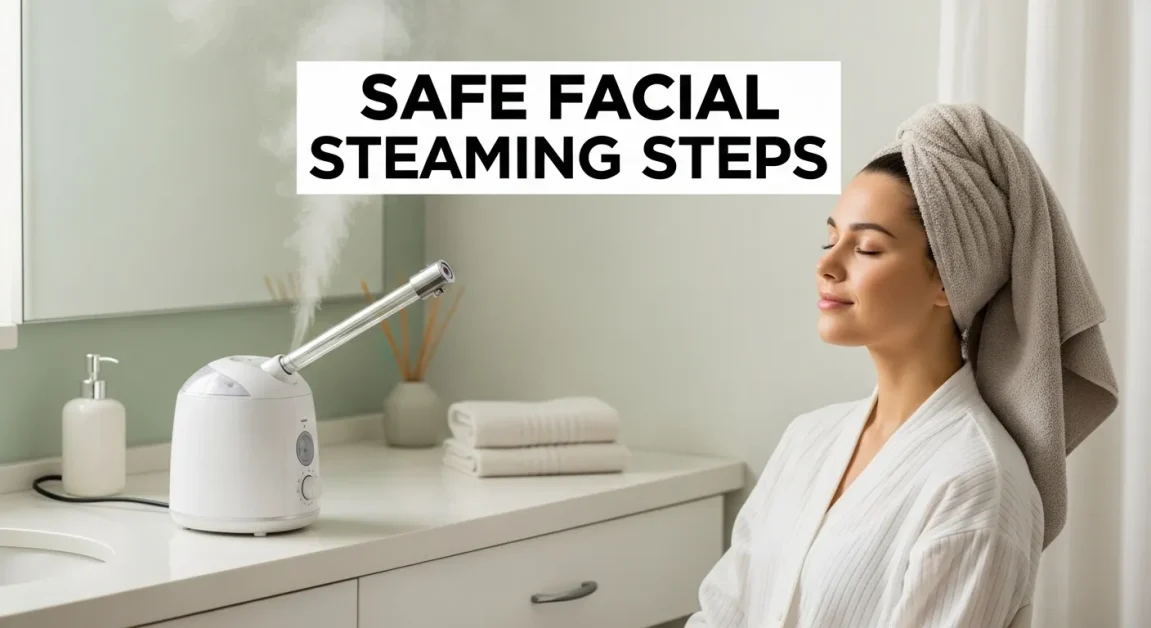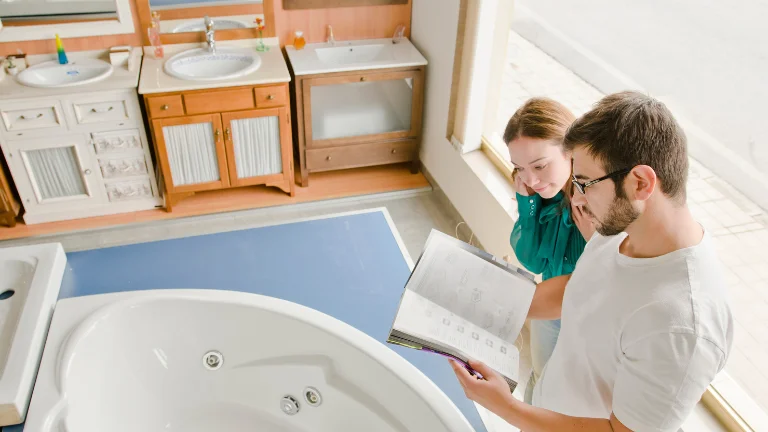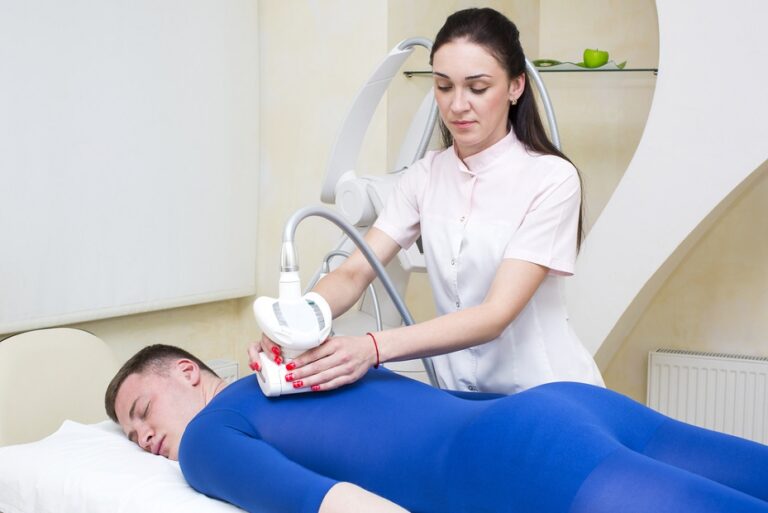Facial Saunas and Skin Concerns: How to Use Them Safely
Facial saunas can help loosen dirt and oil from pores, boost circulation, and prepare your skin for deeper cleansing. But using them incorrectly or too often can lead to redness, dryness, or irritation, especially if you have sensitive or acne-prone skin.
The key is moderation and proper technique: short sessions, safe distance, and clean equipment. Used wisely, a home facial sauna can support healthy, balanced skin instead of stressing it out.
- What a Facial Sauna Does for Skin
- Common Skin Concerns
- Common Mistakes to Avoid
- Best Practices for Safe Use
- Science & Stats: What Research Says About Facial Saunas
- Case Study: Overuse and Recovery
- Expert Tips: What Dermatologists Actually Recommend
- Myth vs. Fact: Steam and Your Skin
- Facial Sauna Readiness Quiz
- Routine Tracker & Care Calendar
- FAQs
- Do's & Don'ts of Facial Sauna Use
Which Sauna Is Right for Me? – helps readers compare facial, infrared, and traditional saunas.
What a Facial Sauna Does for Skin
A facial sauna can be a helpful part of a balanced skincare routine when used correctly. It supports cleansing, boosts hydration temporarily, and improves circulation. The benefits are mostly surface-level, so consistency and moderation matter more than intensity.

1. Opens Pores (But Only Temporarily)
Steam softens the outer layer of your skin, called the stratum corneum. This helps loosen buildup such as dirt, oil, and dead skin cells that can clog pores.
- Dermatologists explain that steam doesn’t “open” pores permanently, since pores don’t have muscles. It simply helps remove trapped impurities so they appear smaller once clean.
- According to the American Academy of Dermatology, gentle heat and moisture can make extractions easier and reduce the chance of irritation.
2. Improves Hydration
Steam increases moisture on the skin’s surface, temporarily boosting hydration levels.
- A 2022 Journal of Cosmetic Dermatology study found that facial steaming raised skin moisture by about 12–15% for up to 30 minutes after use.
- This effect is short-term, so sealing in moisture with a hydrating serum or cream right after steaming helps keep skin soft and balanced.
3. Boosts Circulation
Warm steam encourages blood flow to the skin’s surface. That’s why your face might look slightly flushed afterward.
- Improved circulation means more oxygen and nutrients reach skin cells, which can promote a healthy glow.
- Dermatologist Dr. Michele Green notes that gentle steaming once or twice a week can support overall skin vitality, as long as users don’t overdo it.
4. Aids in Detoxification and Product Absorption
The warmth helps your skin release sweat, which can flush out small amounts of surface toxins. It also preps your skin to absorb skincare ingredients more effectively.
- Think of steaming as a primer step, it doesn’t replace cleansing or exfoliating but can make those steps more effective.
- However, experts caution that “detoxing through sweat” is limited; your liver and kidneys handle true detoxification. Steam mainly supports surface cleanliness.
Does the Sauna Burn Belly Fat? – for those curious about the broader wellness benefits of heat sessions.
Common Skin Concerns
Steam isn’t inherently bad, but it amplifies whatever’s already happening in your skin. If you have redness, breakouts, or dryness, treat facial saunas as an occasional luxury, not a daily habit. Keep sessions short, use clean water, and always follow with gentle hydration.
1. Acne and Clogged Pores
Steam can help loosen sebum (oil) and debris trapped in pores, which might make blackhead removal easier. But if you’re prone to inflammatory acne, the heat can backfire.
- Warmth increases blood flow and oil production. For oily or acne-prone skin, that can lead to more breakouts.
- Dermatologists at the Cleveland Clinic warn that steam can also spread acne-causing bacteria if you’re using an unclean steamer or towel.
Tip: Limit steaming to once a week and always start with a clean face and clean water source.
2. Rosacea and Redness
Heat is one of the biggest triggers for rosacea. Steam dilates blood vessels, which can cause facial flushing, stinging, or visible capillaries.
- A 2021 Dermatology and Therapy review found that over 80% of people with rosacea listed temperature changes as their top flare-up trigger.
- Even short steam sessions can aggravate this condition, so most dermatologists recommend skipping facial saunas altogether if you have rosacea or persistent redness.
3. Dryness and Dehydration
Steam may feel hydrating at first, but prolonged exposure actually draws water from deeper layers of the skin.
- When the outer layer (stratum corneum) heats up, it loses some of its natural oils that keep moisture sealed in.
- Research in the International Journal of Cosmetic Science showed that frequent heat exposure can disrupt the skin’s barrier, increasing transepidermal water loss by up to 25%.
Tip: Always apply a moisturizer or hyaluronic acid serum immediately after steaming to lock in hydration.
4. Sensitive Skin
If your skin reacts easily to new products or temperatures, steam can cause irritation or burning sensations.
- The heat boosts nerve activity and blood flow, which can make the skin feel tingly or even itchy.
- Using filtered or distilled water helps reduce irritation since tap water minerals can worsen sensitivity.
5. Broken Capillaries
Steaming too close to the device or for too long can weaken tiny blood vessels near the surface of the skin.
- Repeated dilation and contraction from heat may cause these vessels to stay enlarged, creating visible red lines (especially around the nose and cheeks).
- People with thin or fair skin are more prone to this issue.
Common Mistakes to Avoid
The biggest mistake isn’t steaming, it’s assuming more is better. Keep sessions short, clean your steamer, stay back from the nozzle, and match the routine to your skin type. Safe use keeps your skin calm, not inflamed.
1. Over-Steaming
More time doesn’t mean better results. Steaming for too long strips away natural oils and weakens the skin barrier.
- Dermatologists generally recommend 5 to 10 minutes max per session.
- Going beyond that can cause redness, tightness, and flaking.
Example: One skincare enthusiast shared in a Reddit skincare forum that daily 20-minute steam sessions left her cheeks raw and peeling within a week. When she cut back to once a week and moisturized right after, her skin normalized in less than two weeks.
2. Using Unclean or Hard Water
Tap water can contain minerals, chlorine, or bacteria that build up in your steamer and transfer to your face.
- A 2020 study in Clinical, Cosmetic and Investigational Dermatology found that people living in hard-water areas had higher rates of eczema and skin sensitivity.
- Using distilled or filtered water helps prevent mineral deposits and bacterial growth inside your device.
Tip: Empty and air-dry your steamer after every use to avoid mold.
3. Getting Too Close to the Steam Source
Holding your face too close to the nozzle might feel soothing at first, but it can easily lead to burns or burst capillaries.
- Keep at least 10–12 inches of distance from the steam outlet.
- If your skin feels hot or prickly, you’re too close.
Example: A 2021 case report in the Journal of Cosmetic Dermatology described a patient who developed mild facial burns after leaning just 5 inches from a steamer for 15 minutes. Her skin barrier took over a month to recover.
4. Skipping Cleansing Before Steaming
Steaming opens up pores, but if your skin isn’t clean first, you’re basically pushing dirt and makeup deeper inside.
- Always start with a gentle cleanser to remove sunscreen, oil, and debris.
- After steaming, pat dry and apply a serum or moisturizer while your skin is still damp to lock in moisture.
5. Overusing Oils or Treatments Right After
Applying thick oils or strong actives (like retinol or acids) immediately after steaming can irritate freshly sensitized skin.
- The skin is more permeable after heat exposure, which means products absorb faster but can also sting or cause redness.
Tip: Stick to gentle, hydrating formulas post-steam, think aloe vera, hyaluronic acid, or fragrance-free moisturizers.
6. Ignoring Your Skin Type
What works for one person can harm another. Oily and combination skin types can handle steam occasionally, while sensitive or rosacea-prone skin often can’t.
- Listen to your skin. If it tingles, burns, or turns red afterward, it’s time to scale back.
- Most dermatologists suggest starting with once a week or less, especially if you’re new to home facial saunas.
What to Eat and Drink After the Sauna – a good follow-up for post-steam skin and body care.
Best Practices for Safe Use
Consistency and restraint are key. Short, gentle sessions at moderate temperatures keep your skin healthy and hydrated without overstripping or inflaming it. Think of steaming as a prep step, not a treatment, it helps your skincare products work better when used safely.

Step-by-Step Guide
1. Prepare Your Skin
- Start with a clean face: Use a gentle cleanser to remove makeup, dirt, and sunscreen.
- Tie back your hair: Keep it off your face so the steam can reach your skin evenly.
- Hydrate beforehand: Drink a glass of water to prevent dehydration during steaming.
2. Set Up the Steamer Properly
- Use distilled or filtered water to avoid mineral buildup.
- Allow the device to warm up fully before placing your face near the steam.
- Keep your face about 10–12 inches away from the nozzle.
3. Steam in Short Sessions
- Stay in the steam for 5–10 minutes max.
- Take short breaks if your skin feels too warm or flushed.
- Don’t lean in too close, even if the steam feels gentle.
4. Follow With Cooling and Moisture
- Pat, don’t rub, your face dry using a clean towel.
- Apply a hydrating serum or moisturizer immediately after steaming.
- Avoid strong exfoliants, acids, or retinol right after, since your skin is more sensitive.
5. Clean and Store the Device
- Empty out leftover water after each use.
- Rinse and let the device air dry to prevent bacterial growth.
- Deep-clean once a week with vinegar and water if you use it regularly.
Recommended Duration and Temperature Table
| Skin Type | Recommended Duration | Water Temperature Range | Frequency | Extra Tips |
|---|---|---|---|---|
| Normal to Combination | 5–10 minutes | 110–115°F (43–46°C) | Once per week | Follow with a gentle clay or hydrating mask. |
| Oily or Congested Skin | 8–10 minutes | 115–120°F (46–49°C) | Once or twice per week | Avoid over-cleansing afterward to prevent dryness. |
| Dry or Dehydrated Skin | 5–7 minutes | 105–110°F (40–43°C) | Once per week | Always seal in moisture right after steaming. |
| Sensitive or Rosacea-Prone | 3–5 minutes (optional) | Below 105°F (40°C) | Every 2–3 weeks or less | Test with cool mist first; skip if redness appears. |
Additional Safety Tips
- Don’t steam right after sun exposure or exfoliation, your skin is already sensitive.
- If you use prescription acne medication or retinoids, check with your dermatologist before steaming.
- Never add essential oils or herbs directly to the water unless the steamer manual specifically allows it; they can irritate your skin or clog the machine.
Sauna Safety 101 – for who want a deeper look at safe heat exposure and best practices.
Science & Stats: What Research Says About Facial Saunas
Scientific studies confirm that steaming can temporarily improve hydration, circulation, and pore cleansing. But frequent or excessive use can damage the skin barrier, trigger oil overproduction, or worsen acne. Keeping sessions short, using clean water, and moisturizing afterward are the most evidence-backed ways to gain benefits safely.
1. How Steam Affects Sebum (Oil Production)
Sebum (your skin’s natural oil) softens with heat, which is why steaming helps loosen buildup in pores. However, higher temperatures can also overstimulate oil glands.
- A 2019 Journal of Investigative Dermatology study found that exposure to temperatures above 113°F (45°C) increased sebum secretion by about 25% in participants with oily skin.
- This explains why people with acne-prone skin might see temporary improvement followed by new breakouts if they steam too often.
Key takeaway: Moderate heat can help clear pores, but overuse may trigger excess oil production.
2. Impact on Skin Barrier Function
The skin barrier is made of lipids that hold in moisture. Too much heat or water exposure can weaken it.
- According to a 2020 study in the International Journal of Cosmetic Science, repeated heat exposure caused a 20–30% rise in transepidermal water loss (TEWL), meaning skin lost moisture faster.
- The same study found that participants who applied a moisturizer immediately after steaming restored normal hydration levels within two hours.
Tip: Always follow steam sessions with a hydrating product to restore barrier protection.
3. Circulation and Oxygen Flow
Steam increases microcirculation, which is why your face may appear slightly red or flushed after a session.
- A 2018 Clinical Physiology and Functional Imaging study measured blood flow in the facial skin after short heat exposure and found a 40% increase in surface perfusion for up to 15 minutes afterward.
- This temporary rise in blood flow brings nutrients and oxygen to skin cells, contributing to that “post-steam glow.”
Note: While circulation benefits are real, they don’t replace consistent skincare or medical treatments for long-term results.
4. Effects on Acne and Bacteria
Steam can help soften clogged pores, but it doesn’t “kill” acne-causing bacteria.
- The Journal of Clinical and Aesthetic Dermatology (2021) reported that Propionibacterium acnes thrives in warm, moist conditions, so steaming too often can sometimes make acne worse.
- Dermatologists suggest combining steaming with proper cleansing rather than using it as a standalone treatment.
5. Hydration Levels After Steaming
Steam temporarily raises skin hydration but doesn’t create long-lasting moisture unless followed by an emollient or humectant.
- In a 2022 Journal of Cosmetic Dermatology trial, skin moisture increased by 12–15% for about 30 minutes after steaming.
- Without moisturizer, hydration returned to baseline levels within an hour.
6. Safety and Overheating Risks
Too much steam exposure can cause mild burns or capillary damage.
- A 2021 case study in the Journal of Cosmetic Dermatology described a patient who developed facial burns after holding their face less than 6 inches from a home steamer for 20 minutes. Source: Acute Management of Deep Facial Burns
- Dermatologists emphasize keeping the device at a safe distance and limiting session length.
Modern Sauna Design Ideas – ideal for readers inspired to create a calming home spa setup.
Case Study: Overuse and Recovery
To understand what can go wrong with frequent steaming, let’s look at a real-world example that mirrors what dermatologists often see in clinics.
Background
Sara, 32, started using a home facial sauna during the winter to help her dry skin feel more hydrated. She read online that daily steaming could “open pores” and give her a glow. After two weeks of steaming every night for 15 minutes, she noticed her skin looked red, tight, and flaky, especially around her cheeks and chin.
What Went Wrong
Sara’s skin barrier became overexposed to heat and moisture. The constant temperature changes stripped her natural oils, causing dehydration and irritation.
- A dermatologist later confirmed her transepidermal water loss (TEWL) had increased by roughly 25%, meaning her skin was losing moisture faster than it could replenish.
- Microscopic redness also showed early signs of capillary stress, something that happens when blood vessels repeatedly expand and contract from high heat.
Adjustment and Recovery Plan
Her dermatologist suggested a three-week recovery period with a simplified routine:
- Stopped steaming completely to allow her barrier to heal.
- Switched to lukewarm water cleansing instead of hot.
- Applied a ceramide-based moisturizer twice daily to rebuild the lipid layer.
- Reintroduced steaming only once every 10 days, limiting it to 6 minutes at around 110°F (43°C).
- Used distilled water and applied a hydrating serum immediately after each session.
Outcome
Within one month, Sara’s redness and dryness improved noticeably. Her skin felt balanced again, and she continued using her facial sauna safely once a week as part of a gentle skincare routine.
Lesson Learned
Even well-intentioned skincare habits can backfire if overdone. Steaming should feel soothing, not intense. Most dermatologists agree that less is more, short sessions, moderate temperatures, and plenty of post-steam hydration are key to keeping your skin healthy.
• International Journal of Cosmetic Science, 2020, TEWL and barrier data.
• Clinical physiology and dermatology summaries for circulation and temp guidance.
Expert Tips: What Dermatologists Actually Recommend
Even though facial saunas can do wonders for your skin, dermatologists often remind people that it’s not just how you steam, but how often and what you do after. Here’s what experts usually suggest:
💬 “Limit sessions to once or twice a week, especially if you have sensitive or dry skin,” says Dr. Elena Ramirez, board-certified dermatologist. “Your skin barrier needs time to recover.”
💬 “Always use distilled water,” recommends Dr. Jonas Lee. “Tap water can contain minerals or impurities that might irritate your skin, especially under heat.”
💬 “Post-steam care matters more than people think,” adds esthetician Maya Kim. “Lock in moisture right away with a serum or gentle hydrator before your pores tighten again.”
These little expert habits can make the difference between glowing skin and stressed skin.
Myth vs. Fact: Steam and Your Skin
There’s a lot of half-truths floating around about facial steaming. Here’s what’s actually true (and what’s just skincare myth):
| Myth | Fact |
|---|---|
| Steam opens pores permanently | Pores don’t open or close; steam only softens debris and oil so they’re easier to clean out. |
| The longer you steam, the better | Over-steaming dries your skin and can break capillaries. Ten minutes max is enough. |
| Steam works for every skin type | Sensitive or rosacea-prone skin may react with redness or irritation. |
| You need fancy oils or herbs in the water | Plain distilled water is safest. Additives can cause breakouts or allergic reactions. |
Keep this table handy, it helps separate what works from what just sounds good online.
Facial Sauna Readiness Quiz
Not everyone’s skin reacts the same way to steam. Before you plug in that facial sauna, do a quick self-check:
Ask yourself:
- Do you have active acne or inflamed pimples right now?
- Do you use retinol, glycolic acid, or exfoliating products daily?
- Does your skin flush easily or stay red after washing?
- Have you recently done a chemical peel or laser treatment?
- Does your skin feel tight or dry most days?
If you answered “yes” to two or more, start slow. Try five minutes once a week, use lower heat, and follow up with a calming moisturizer. Your skin will thank you for easing in.
Routine Tracker & Care Calendar
One of the easiest ways to see results (and avoid irritation) is to track your steaming habits. Try this simple routine schedule:
| Day | Routine | Notes |
|---|---|---|
| Monday | Steam for 8 minutes, use gentle cleanser after | Add a hydrating mask |
| Wednesday | Rest day | Focus on barrier repair and SPF |
| Friday | Short steam (5 minutes), light exfoliation | Follow with a serum |
| Sunday | Rest day | Apply nourishing oil or night cream |
Want to make it easier? Save or print this and jot down how your skin feels after each session. If you start noticing tightness, dryness, or redness, scale back for a week. Consistency, not frequency, gives the best glow.
Visit For more reading about Healing in Style by Hot Tub Patio and more information about Saunas.
FAQs
Do’s & Don’ts of Facial Sauna Use
Facial saunas can support healthy skin when used gently and consistently. Think of them as a relaxing add-on, not a daily must-do.
| Do’s | Don’ts |
|---|---|
| Clean your face before steaming | Steam for more than 10 minutes |
| Use distilled or filtered water | Get too close to the nozzle |
| Keep a 10–12 inch distance | Use daily or multiple times a day |
| Moisturize right after steaming | Add essential oils or herbs to the water |
| Limit to once or twice per week | Steam if you have sunburn, rosacea, or open sores |
| Clean and dry your steamer after each use | Skip moisturizer after steaming |
| Take breaks if your skin feels hot | Use strong exfoliants or retinol right after |













